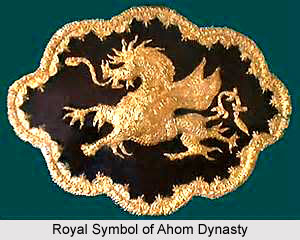 Sunenphaa was an Ahom king who ruled over the Ahom kingdom from 1744 to 1751 AD. He was also known as Pramatta Singha. Sunenphaa ascended the throne after his elder brother Siba Singha who was also an Ahom king. He ruled for about seven years and his reign was characterized by peace and prosperity. He owns the credit of constructing a number of temples and buildings out of which the Rang Ghar is the most famous one and is the oldest amphitheatre of Asia.
Sunenphaa was an Ahom king who ruled over the Ahom kingdom from 1744 to 1751 AD. He was also known as Pramatta Singha. Sunenphaa ascended the throne after his elder brother Siba Singha who was also an Ahom king. He ruled for about seven years and his reign was characterized by peace and prosperity. He owns the credit of constructing a number of temples and buildings out of which the Rang Ghar is the most famous one and is the oldest amphitheatre of Asia.
Coronation of Sunenphaa
Sunenphaa was the second son of the Ahom king Rudra Singha and held the position of Charing Raja during the reign of his elder brother. As per the wishes of Rudra Singha, Sunenphaa was installed as the king after the death of his elder brother by Chengmung Burhagohain of Pukhuriparia clan. When Swargadeo Siba Singha died, his son Ugra Singha was at the post of Tipam Raja. When the decision of making Pramatta Singha the king was made by the nobles, it was opposed by another section of nobles of the kingdom. They wanted to install the Tipam Raja as the king. The group of nobles in favour of Tipam Raja was met by the Charing Raja along with his three brothers and some nobles, at the palace. The nobles of Tipam Raja were however neutralized in the confrontation and the Charing Raja was installed on the throne. The coronation ceremony, also known as Singarigharutha ceremony, continued for about eight days. The Tai-Ahom priests assigned the name Sunenphaa to the new king and envoys of Jaintia kingdom and Kachari kingdom attended the ceremony to greet the new Swargadeo.
Punishing the Rebels
After being coronated as the king, Sunenphaa punished the nobles who stood against him, including Kalugayan Borpatrogohain, by dismissing them from the office. Mrittunjay Gohain was appointed as the new Borpatrogohain. Apart from dismissing them from the office, the rebels were also imprisoned and chained. The Sraddha ceremony of the deceased king was done in the month of Phagun, according to Hindu calendar. Several religious preachers were invited to the ceremony. The trial of the rebels took place in the month of Chaitra, against whom light charges were placed. They were given minor punishments and sent home.
Envoy of Rani
It was a rule of the tributary rulers under Ahom rule that they have to offer their submission to the new king with gifts at the time of coronation ceremony or after it. The Ahom rulers always used to maintain an amicable relationship with their tributary kingdoms. Rani was one of the tributary kingdoms, that was located in the southern part of Kamrup district. Garos and Karbis were the main inhabitants of the kingdom. Right from time of Ahom-Mughal conflicts, this kingdom had an association with the Ahoms. During the princely days, Pramatta Singha was once hiding in the kingdom of Rani during the rule of a notorious king Lora Raja, at the house of a Garo lady. When Pramatta Singha succeeded the throne, an envoy named Rup was sent to the Ahom kingdom to offer submission and greeting to the new king. On interrogation by Chengmung Burhagohain, the envoy of Rani narrated about the neglect they have been facing from the royal family since long. On the way back, gifts and presents were handed to the envoy for the king of Rani.
Temples and Monuments
A number of buildings were erected by Sunenphaa during his rule. Rang Ghar, an amphitheatre made of bricks is famed for animal fights and other activities that take place during the festivals like Bihu. The temples of Sukreswar and Janardan were also established by Sunenphaa in Guwahati. He also built a temple at North Guwahati in 1751 CE. It was the place where Rudra Singha died. The temple also houses an image of Shiva, also known as Rudreswar. The maintenance of the temple was assigned to lands and paiks. Building at Hajo including a Ganesh temple and the Fakuwa Dol were also erected by him, which were situated near Hayagriva Madhab temple. The festival of Holi is celebrated here every year. The boundary wall of Hayagriva Madhab temple was also constructed during this period. Sunenphaa also started a settlement operation in Kamrup and lower Assam. For this purpose, records of land right were carefully maintained.
Death of Sunenphaa
Sunenphaa died in the year 1751 and his death is associated with an interesting story. The king often complained about excruciating headaches. He also had a dream that his headache would be cured if he offered prayers to the holy shrine of Islam. Thus arrangements were made for the journey of a Muslim cleric to Mecca. The cleric had instructions of offering prayers for the good health and long life of the king and he acted accordingly. But unfortunately before his return, after two and a half years, the king died of illness.



















